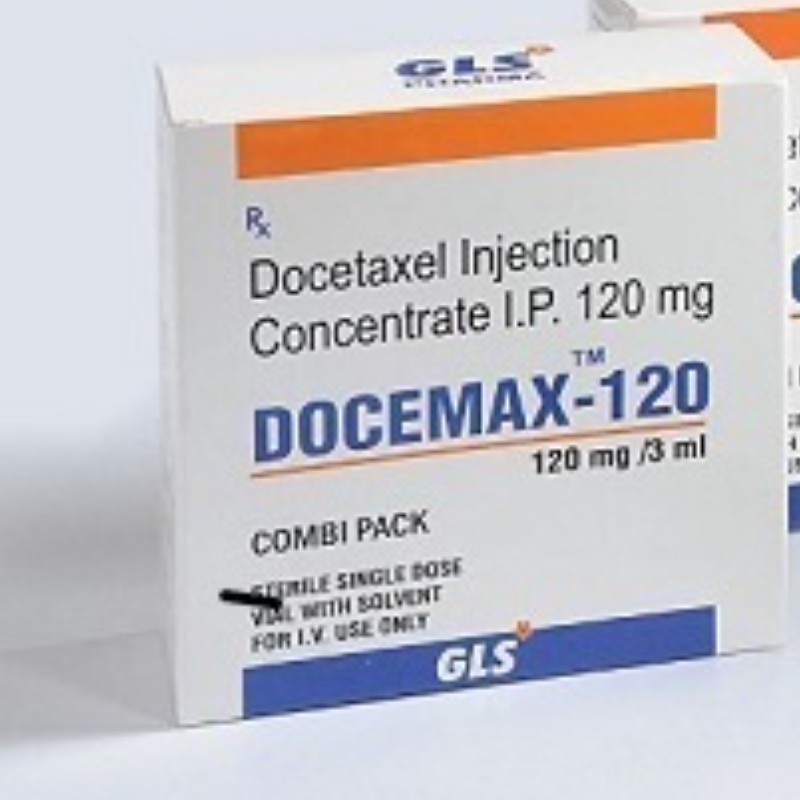DESCRIPTION
Mechanism of Action
• Semisynthetic taxane. Derived from the needles of the European yew
tree.
• High-affinity binding to microtubules enhances tubulin polymerization.
Normal dynamic process of microtubule network is inhibited, leading
to inhibition of mitosis and cell division.
• Cell cycle–specific agent with activity in the mitotic (M) phase.
Mechanism of Resistance
• Alterations in tubulin with decreased affinity for drug.
• Multidrug-resistant (MDR-1) phenotype with increased expression of
P170 glycoprotein. Results in enhanced drug efflux with decreased
intracellular accumulation of drug. Cross-resistant to other natural
products, including vinca alkaloids, anthracyclines, taxanes, and
VP-16.
Absorption
Not administered orally.
Distribution
Distributes widely to all body tissues. Extensive binding (.90%) to plasma
and cellular proteins.
Metabolism
Extensively metabolized by the hepatic P450 microsomal system. About
75% of drug is excreted via fecal elimination. Less than 10% is eliminated as
the parent compound with the majority being eliminated as metabolites.
Renal clearance is relatively minor with less than 10% of drug clearance via
the kidneys. Plasma elimination is tri-exponential with a terminal half-life
of€11 hours.
Indications
1. Breast cancer—FDA-approved for the treatment of locally advanced
or metastatic breast cancer after failure of prior chemotherapy.
2. Breast cancer—FDA-approved in combination with doxorubicin and
cyclophosphamide for adjuvant treatment of patients with node-positive
breast cancer.
3. Non–small cell lung cancer—FDA-approved for locally advanced or
metastatic disease after failure of prior platinum-based chemotherapy.
4. Non–small cell lung cancer—FDA-approved in combination with
cisplatin for treatment of patients with locally advanced or metastatic
disease who have not previously received chemotherapy.
5. Prostate cancer—FDA-approved in combination with prednisone
for androgen-independent (hormone-refractory) metastatic prostate
cancer.
6. Gastric cancer—FDA-approved in combination with cisplatin and
5-fluorouracil for advanced gastric cancer, including adenocarcinoma
of the gastroesophageal junction, in patients who have not received
prior chemotherapy.
7. Head and neck cancer—FDA-approved for use in combination with
cisplatin and 5-fluorouracil for induction treatment of patients with
inoperable, locally advanced disease.
8. Small cell lung cancer.
9. Refractory ovarian cancer.
10. Bladder cancer.
Dosage Range
1. Metastatic breast cancer—60, 75, and 100 mg/m2 IV every 3 weeks
or 35–40 mg/m2 IV weekly for 3 weeks with 1-week of rest.
2. Breast cancer—75 mg/m2 IV every 3 weeks in combination with
cyclophosphamide and doxorubicin for adjuvant therapy.
3. Non–small cell lung cancer—75 mg/m2 IV every 3 weeks or
35–40 mg/m2 IV weekly for 3 weeks with 1-week rest after platinumbased
chemotherapy.
4. Non–small cell lung cancer—75 mg/m2 IV every 3 weeks in combination
with cisplatin in patients who have not received prior
 chemotherapy.
5. Metastatic prostate cancer—75 mg/m2 IV every 3 weeks in combination
with prednisone.
6. Advanced gastric cancer—75 mg/m2 IV every 3 weeks in combination
with cisplatin and 5-FU.
7. Head and neck cancer—75 mg/m2 IV every 3 weeks in combination
with cisplatin and 5-FU for induction therapy of locally advanced disease.
Drug Interaction 1
Radiation therapy—Docetaxel acts as a radiosensitizing agent.
Drug Interaction 2
Inhibitors and/or activators of the liver cytochrome P450 CYP3A4 enzyme
system—Concurrent use with drugs such as cyclosporine, ketoconazole, and
erythromycin may affect docetaxel metabolism and its subsequent antitumor
and toxic effects.
Special Considerations
1. Use with caution in patients with abnormal liver function. Patients
with abnormal liver function are at significantly higher risk for toxicity,
including treatment-related mortality.
2. Closely monitor CBCs; docetaxel therapy should not be given to
patients with neutrophil counts of ,1500 cells/mm3.
3. Patients should receive steroid premedication to reduce the incidence
and severity of fluid retention and hypersensitivity reactions. Give
dexamethasone 8 mg PO bid for 3 days beginning 1 day before drug
administration.
4. Closely monitor patients for allergic and/or hypersensitivity reactions,
which are related to the polysorbate 80 vehicle in which the
drug is formulated. Usually occur with the first and second treatments.
Emergency equipment, including Ambu bag, ECG machine,
fluids, pressors, and other drugs for resuscitation, must be at bedside
before initiation of treatment.
5. Contraindicated in patients with known hypersensitivity reactions to
docetaxel and/or polysorbate 80.
6. Use only glass, polypropylene bottles, or polypropylene or polyolefin
plastic bags for drug infusion. Administer only through polyethylenelined
administration sets.
7. Monitor patient’s weight, measure daily input and output, and evaluate
for peripheral edema.
8. Pregnancy category D. Breastfeeding should be avoided.
Toxicity 1
Myelosuppression. Neutropenia is dose-limiting with nadir at days 7–10
and recovery by day 14. Thrombocytopenia and anemia are also observed.
Toxicity 2
Hypersensitivity reactions with generalized skin rash, erythema, hypotension,
dyspnea, and/or bronchospasm. Usually occur within the first
2–3 minutes of an infusion and almost always within the first 10 minutes.
Most frequently observed with first or second treatments. Usually prevented
by premedication with steroid; overall incidence decreased to less than 3%.
When it occurs during drug infusion, treat with hydrocortisone IV, diphenhydramine
50 mg IV, and/or cimetidine 300 mg IV.
Toxicity 3
Fluid retention syndrome. Presents as weight gain, peripheral and/or
generalized edema, pleural effusion, and ascites. Incidence increases with
total doses .400 mg/m2. Occurs in about 50% of patients.
Toxicity 4
Maculopapular skin rash and dry, itchy skin. Most commonly affect forearms
and hands. Brown discoloration of fingernails may occur. Observed in
up to 50% of patients usually within 1 week after therapy.
Toxicity 5
Alopecia occurs in up to 80% of patients.
Toxicity 6
Mucositis and/or diarrhea seen in 40% of patients. Mild-to-moderate
nausea and vomiting, usually of brief duration.
Toxicity 7
Peripheral neuropathy is less commonly observed with docetaxel than
with paclitaxel.
Toxicity 8
Generalized fatigue and asthenia are common, occurring in 60%–70% of
patients. Arthralgias and myalgias also observed.
Toxicity 9
Reversible elevations in serum transaminases, alkaline phosphatase, and
bilirubin.
Toxicity 10
Vesicant. Phlebitis and/or swelling can be seen at the injection site.
SPECIFICATION


Login To Comment